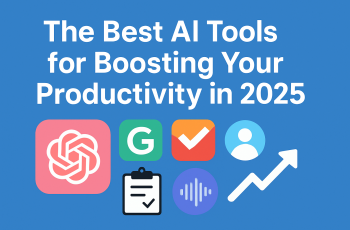In a world where burnout and information overload are all too common, AI is stepping in not to replace workers — but to help them work smarter. In 2025, artificial intelligence has become a key part of the modern workflow, reducing repetitive tasks, improving focus, and helping people unlock more productive hours in the day.
Here’s how everyday professionals — from freelancers to corporate employees — are using AI to optimize the way they work.
1. Streamlining Routine Tasks
Many knowledge workers now rely on tools like Zapier, Notion AI, or Trello’s AI assistant to automate routine admin tasks. That might mean:
- Automatically sorting emails into categories
- Pre-filling repetitive reports
- Scheduling recurring meetings based on team availability
These small automations add up to hours saved every week.
2. Faster Writing and Content Generation
Writers, marketers, and students are using AI tools like ChatGPT, GrammarlyGO, or Copy.ai to jumpstart the creative process. Whether it’s drafting emails, summarizing meeting notes, or generating blog outlines, AI cuts down the “blank page” phase significantly.
Importantly, many professionals use AI as a first draft — then revise to add their own tone and insight. It’s a collaboration, not a replacement.
3. Organizing Knowledge More Efficiently
Tools like Mem.ai, Obsidian, and Notion now integrate AI to surface relevant notes, summarize long documents, and even create structured outlines from unstructured data. This makes it easier to retain and apply information — whether you’re studying, preparing a report, or building a strategy.
Instead of endlessly searching folders, users get “context-aware” suggestions in real time.
4. Smarter Time Management
AI scheduling tools like Clockwise, Reclaim.ai, and Motion are gaining traction for helping users defend focus time. These tools look at your habits, meetings, and tasks — then adjust your calendar to prioritize deep work.
They even move non-urgent meetings automatically when they detect an overload.
5. Enhanced Focus Through AI-Powered Distraction Management
Some apps now use AI to track your digital attention span — detecting when you’re off task (like switching tabs) and gently nudging you back to focus. Tools like RescueTime, Serene, or Focusmate help users reclaim time lost to digital distractions.
Some AI productivity tools even block distracting websites until you’ve met a goal.
Conclusion:
AI isn’t about doing everything for you — it’s about removing friction so you can spend your time and energy where it really matters. In 2025, workers who learn how to leverage AI as a partner are gaining a distinct edge in productivity — and finding more balance along the way.
